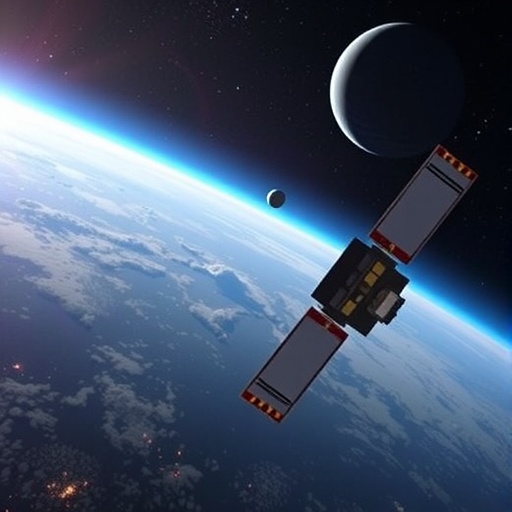The advent of mega-constellations, such as SpaceX’s Starlink, presents unprecedented challenges and opportunities in the realm of outer space. A recent study from a team of researchers at the National University of Defense Technology introduces a groundbreaking framework for addressing the mounting congestion crisis in orbit—an embedding system dubbed the Open and Shared Sustainable Mega-Constellation (OSSMC). This innovative approach shifts the paradigm of satellite deployment and operational methodology towards a more sustainable and cooperative model, promising to reshape the future of space exploration and utilization.
Modern advancements in satellite technology have led to a proliferation of proposals for mega-constellations, resulting in projections of over one million satellites in orbit. This scenario has culminated in what many experts deem a “congestion crisis” within near-Earth space. Concerns regarding this overcrowding have escalated, as noted in prestigious journals like Nature and Science, which have sounded alarms about the implications of a trajectory that could see satellite numbers exceeding safe operational limits. This unsustainable model could well compromise not just the integrity of satellite operations but also the long-term viability of space as an environment for research and exploration.
The OSSMC emerges as an innovative response to this dilemma, proposing an architecture based on the values of openness and shared resources. At its core lies an architecture known as Sensors + Network + AI (SANI). This modular approach repurposes satellites into components—sensors, networking capabilities, and AI-driven computing units—that can interact dynamically. By enabling satellites to share resources and operational capacities on-demand rather than mandating fixed roles, this architecture promises to streamline functionality and optimize overall system efficiency.
Another key component of the OSSMC is the “Cloud Pool Terminal” (CPT) paradigm. This visionary approach aims to create a non-redundant global resource pool that interconnects space cloud platforms, satellite pools, and user terminals. The result is a cohesive shared infrastructure that can enhance operational capabilities. This unprecedented collaboration among satellites would replace isolated, redundant national satellite constellations, reminiscent of contemporary internet-based resource sharing that has revolutionized communication technologies.
Experimental assessments of OSSMC have yielded promising results, highlighting substantial improvements in several critical performance indicators. The OSSMC framework is projected to stabilize the number of active satellites at approximately 48,000 by 2036 while continuing to offer customized, real-time services to a burgeoning global population projected to reach 8 billion. The ability to balance satellite quantity with service provision could indeed herald a transformative shift in how satellite services are conceptualized and delivered.
In practical terms, performance gains from the OSSMC architecture are particularly noteworthy. The system’s task success rate has reportedly improved from 26.21% to a striking 45.73%, indicating vastly enhanced efficiency in mission execution. Furthermore, navigation accuracy, measured through Geometric Dilution of Precision (GDOP), demonstrates a 51.07% enhancement over existing systems, such as Centispace. These advancements are critical in fostering reliable navigation and operational coordination in an increasingly crowded orbital environment.
Sustainability is another pronounced benefit articulated in the findings associated with the OSSMC. Comparative evaluations suggest that this system reduces the likelihood of collisions in space by 28.7%, a crucial factor when considering the ramifications of space debris. Additionally, the orbital impact score is reduced by 53.15%, effectively mitigating risks associated with the accumulation of detritus in low Earth orbit and contributing to a healthier space environment.
As Yang Jun, a leading researcher on the project, articulates, the OSSMC offers a dual-faceted technical solution that addresses the pressing challenges of sustainable space systems. This innovation does not merely act as a stopgap but instead seeks to transform the operational landscape by promoting collaborative construction, sharing, and utilization of satellite systems. In doing so, it establishes a framework that could significantly advance international cooperation in the exploration and use of outer space.
The implications of this architecture extend beyond mere operational improvements; they resonate with broader ethical and governance frameworks associated with space utilization. By transitioning from fragmented, nation-specific deployments to a globally shared infrastructure, the OSSMC aligns closely with the United Nations Outer Space Treaty’s principles of shared orbital heritage and equitable access. The potential to recalibrate how societies view and make use of space resources cannot be understated, reflecting a paradigm shift in both perspective and policy.
As humanity stands on the precipice of a new era in space exploration, the shift towards the OSSMC offers hope for resolving the complexities of orbital congestion. This innovative architecture champions the idea that sustainable development is achievable not through sheer numbers but through intelligent design and cooperative strategies. As we push the boundaries of our exploration beyond Earth, this initiative provides a timely and critical reminder that collaboration can yield not only operational efficiency but also pave the way toward a sustainable future.
Ultimately, the OSSMC presents a multifaceted model poised to redefine the commercial space sector and the standards under which satellite constellations are designed and managed. By embracing a philosophy of shared resources and innovative architectures, we might not only mitigate current crises but also unlock new possibilities for scientific research and interstellar endeavors. The future of outer space exploration hinges on such innovative thinking and cooperative efforts, making OSSMC a beacon of promise in the vast expanse of the cosmos.
Subject of Research: Open and Shared Sustainable Mega-Constellation
Article Title: Transforming the Cosmos: The Promise of the Open and Shared Sustainable Mega-Constellation
News Publication Date: [Not specified]
Web References: [Not specified]
References: [Not specified]
Image Credits: ©Science China Press
Keywords
Mega-Constellation, Sustainability, Space Infrastructure, Satellite Efficiency, Collaborative Model, OSSMC, SANI Architecture, Cloud Pool Terminal, Orbital Congestion, Space Debris.




